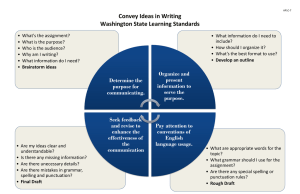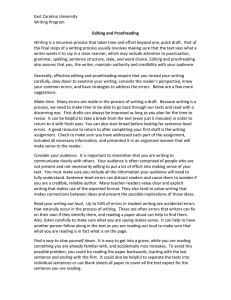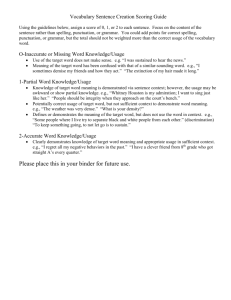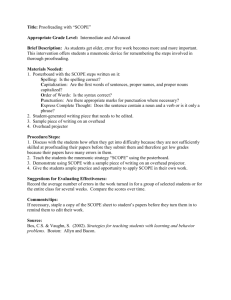-1- Professional Writing As a speech
advertisement
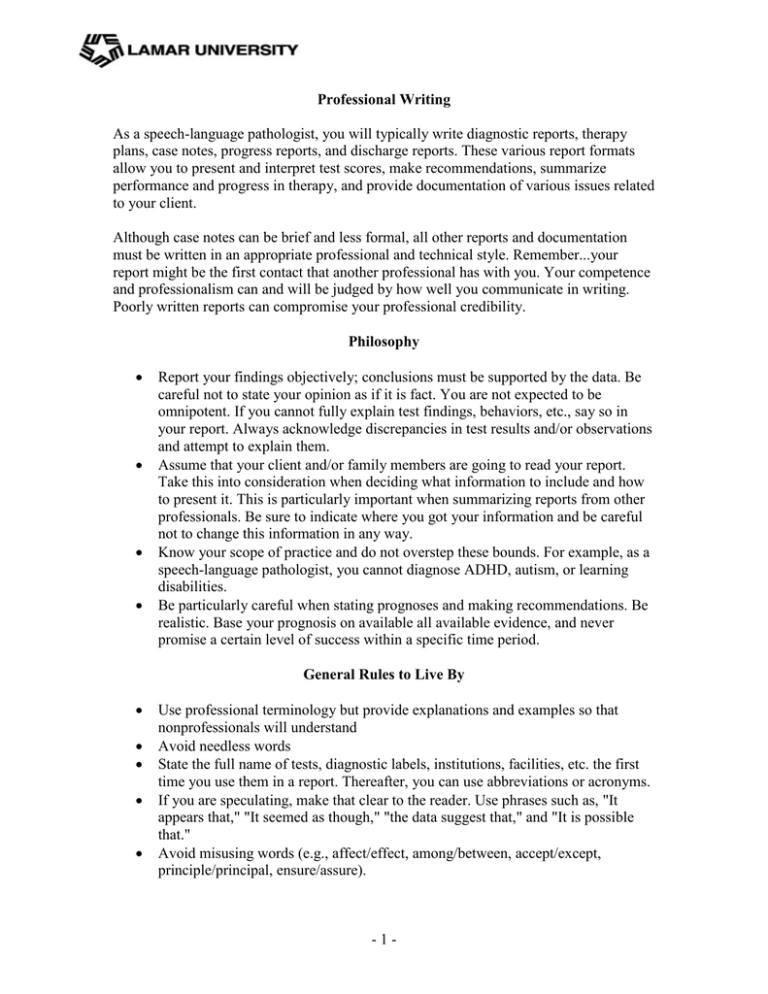
Professional Writing As a speech-language pathologist, you will typically write diagnostic reports, therapy plans, case notes, progress reports, and discharge reports. These various report formats allow you to present and interpret test scores, make recommendations, summarize performance and progress in therapy, and provide documentation of various issues related to your client. Although case notes can be brief and less formal, all other reports and documentation must be written in an appropriate professional and technical style. Remember...your report might be the first contact that another professional has with you. Your competence and professionalism can and will be judged by how well you communicate in writing. Poorly written reports can compromise your professional credibility. Philosophy Report your findings objectively; conclusions must be supported by the data. Be careful not to state your opinion as if it is fact. You are not expected to be omnipotent. If you cannot fully explain test findings, behaviors, etc., say so in your report. Always acknowledge discrepancies in test results and/or observations and attempt to explain them. Assume that your client and/or family members are going to read your report. Take this into consideration when deciding what information to include and how to present it. This is particularly important when summarizing reports from other professionals. Be sure to indicate where you got your information and be careful not to change this information in any way. Know your scope of practice and do not overstep these bounds. For example, as a speech-language pathologist, you cannot diagnose ADHD, autism, or learning disabilities. Be particularly careful when stating prognoses and making recommendations. Be realistic. Base your prognosis on available all available evidence, and never promise a certain level of success within a specific time period. General Rules to Live By Use professional terminology but provide explanations and examples so that nonprofessionals will understand Avoid needless words State the full name of tests, diagnostic labels, institutions, facilities, etc. the first time you use them in a report. Thereafter, you can use abbreviations or acronyms. If you are speculating, make that clear to the reader. Use phrases such as, "It appears that," "It seemed as though," "the data suggest that," and "It is possible that." Avoid misusing words (e.g., affect/effect, among/between, accept/except, principle/principal, ensure/assure). -1- Beware of unusual singulars and plurals (e.g., datum/data, criterion/criteria, phenomenon/phenomena, locus/loci, parenthesis/parentheses) Use commas, hyphens, colons and semi-colons correctly. Remember...."Punctuation marks are the traffic signals of language. They tell us to slow down, notice this, take a detour, and stop." (Lynne Truss in Eats Shoots, and Leaves) Know your Latin abbreviations and use them correctly (e.g. means "for example,” i.e. means “that is”). Technical Writing Style Avoid writing clinical reports in a conversational style (e.g., "He just didn't get the point" versus "He did not appear to understand the task"). Use correct spelling, grammar, and punctuation and write in complete sentences. Write in the third person (e.g., "The Token Test was administered" rather than "I administered the Token Test"). Avoid use of contracted verb forms (e.g., isn't, can't, I've). Give the full names of tests when first mentioned before using acronyms and other abbreviations in the remainder of the report. Express information in behavioral terms (e.g., "followed two-step commands" versus "is able to follow two-step commands"). Present information (particularly case history) in chronological sequence. Differentiate clearly between information reported by others versus information obtained directly through clinician observation. List all data such as test scores or baseline measures before providing any interpretative statements. This approach facilitates interpretation of a client's overall profile rather than presenting unrelated descriptions of isolated communication skills. Include information about a client's strengths as well as weaknesses in the body of the report. Avoid presenting information in the summary section of any report that was not introduced previously in the body of the report. Write reports to communicate with colleagues using professional terminology, but include simple explanations and clear examples to make reports meaningful to family members and other nonprofessionals. Use language that is specific and unambiguous (e.g., "He demonstrated language skills characteristic of 4-year-old children" versus "He demonstrated poor language skills"). Avoid exaggeration and overstatement (e.g., “completely uncooperative,” “absolutely intelligible,” “never produces /s/,” “extremely motivated”). Proofreading A first draft is your first finished report. -2- o It should be neat, complete and proofed. All drafts must be wordprocessed and printed double-spaced. o Completed test forms/data sheets should be turned in with your first draft. o All previous drafts must be given to the supervisor with each subsequent draft, revision or final copy. o Final copies should be single-spaced. Before you hand in your first draft and all subsequent drafts... o Make sure that you have used the required report format. o Read the report over....aloud! You are more likely to catch errors that way. o Check for typos, spelling errors, and grammar errors. When you get your report back from the supervisor o Read over the comments and ask for clarification when needed. o As you make each suggested change, check it off in a different color ink to make certain that you have addressed all edits. Here are some additional tips for proofreading Tips For Proofreading Clinical Reports Students, beginning clinicians, and supervisors can use the following set of proofreading questions to edit and monitor the quality of clinical reports. Are spelling, grammar, and punctuation correct? Are professional terms used accurately? Is there redundancy of word usage or sentence type? Are any sentences too lengthy, rambling, or unfocused? Is all the important client information included in the report? Is information presented only in the germane sections of the report (e.g., recommendation statements should not be included in the background information section)? Does the report follow a logical sequence from one section to the next (i.e., from background, to data and interpretation, to summary and recommendations)? Are raw data interpreted and not merely reported? Are all conclusions and assumptions supported by sufficient data? Are speculative statements explicitly identified as such? Does the report contain seemingly contradictory statements without adequate explanation? Is the wording clear or are some statements vague and ambiguous? Is content presented with appropriate emphasis (e.g., Has any critical information been overlooked? Has any minor point been overemphasized?)? Is the report written with ethical/legal considerations in mind? Roth, F.P. & Worthington, C.K. (2005). Treatment Resource Manual for Speech-Language Pathology. Third Edition. Clifton Park, NY. Thomson Delmar Learning. -3-
